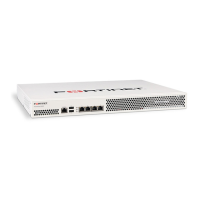Fortinet Technologies Inc. Page 12 FortiVoice 200D/200D-T v2.0 MR1 CLI Reference
numbered sets are sometimes referenced by other parts of the configuration that use them.
(See “Notation” on page 12.)
• field — The name of a setting, such as ip or hostname. Fields in some tables must be
configured with values. Failure to configure a required field will result in an invalid object
configuration error message, and the FortiVoice unit will discard the invalid table.
• value — A number, letter, IP address, or other type of input that is usually your configuration
setting held by a field. Some commands, however, require multiple input values which may
not be named but are simply entered in sequential order in the same command line. Valid
input types are indicated by constraint notation. (See “Notation” on page 12.)
• option — A kind of value that must be one or more words from of a fixed set of options. (See
“Notation” on page 12.)
Indentation
Indentation indicates levels of nested commands, which indicate what other sub-commands
are available from within the scope.
For example, the edit sub-command is available only within a command that affects tables,
and the next sub-command is available only from within the edit sub-command:
config system interface
edit port1
set status up
next
end
For information about available sub-commands, see “Sub-commands” on page 14.
Notation
Brackets, braces, and pipes are used to denote valid permutations of the syntax. Constraint
notations, such as <address_ipv4>, indicate which data types or string patterns are
acceptable value input.
Table 1: Command syntax notation
Convention Description
Square brackets [ ]
A non-required word or series of words. For example:
[verbose {1 | 2 | 3}]
indicates that you may either omit or type both the verbose word
and its accompanying option, such as:
verbose 3

